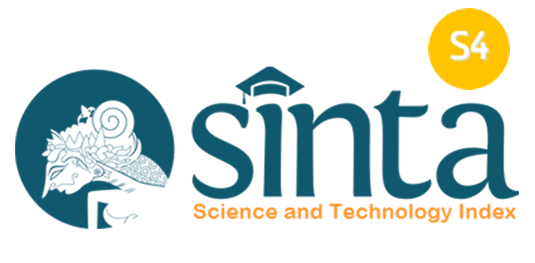Efektivitas Metode Jarimatika dalam Meningkatkan Kemampuan Berhitung Perkalian Siswa
Abstract
This study aims to determine the effectiveness of the Jarimatika method in improving the multiplication ability of grade III students of MI Manba'ul Huda Tunjungrejo for the 2019/2020 academic year. This study describes the application of the Jarimatika method to the third grade students of MI Manba'ul Huda and then analyzes the suitability of the theory with practice so that its effectiveness can be determined. Collecting data in this study used interview and documentation methods while data analysis used Milles and Huberman's model analysis, namely data reduction, data presentation, data verification. The results of this study indicate that the application of the Jarimatika method can improve students' numeracy skills. Students look active and happy when applying the Jarimatika method. The test results showed that the majority of students had good multiplication arithmetic skills. In addition, there are three criteria for the effectiveness of learning methods that must be met. First, the learning completeness of grade III students shows that the majority of students have exceeded the minimum completeness criteria. Second, there is an increase and a difference between initial understanding and after learning. Third, it can increase the interest and motivation of students who have difficulty calculating multiplication
References
Asih, N.M. (2009). Penerapan metode jarimatika untuk meningkatkan pemahaman konsep penjumlahan dan pengurangan pada siswa kelas 1 dan 2 SDN 6 Sesetan, Denpasar Selatan. Jurnal Pendidikan dan pembelajaran, 16 (1).
Bungin, B. (2008). Penelitian Kualitatif (Komunikasi, Ekonomi, Kebijakan Publik, dan Ilmu Sosial Lainnya). Kencana Perdana Media Group.
Dewi, V.F.,Suryana, Y., & Hidayat, S. (2020). Pengaruh Penggunaan Jarimatika terhadap kemampuan Berhitung Perkalian Peserta Didik Kelas IV Sekolah Dasar. Edubasic Journal: Jurnal Pendidikan Dasar, 2(2).
Fauzatun, A. (2020). Wawancara
Hadi, S. (2000). Metodologi Research Jilid 1. Andi Offset
Idi, A. (2010). Pengembangan Kurikulum Teori dan Praktik. Ar-Ruz Media.
Machmudah, U. & Wahab, A. (2008). Active Learning dalam Pembelajaran Bahasa Arab. UIN Malang Press.
Mariyati, Y, & Sari, N. (2017). Efektifitas Penggunaan jarimatika dalam Meningkatkan Keterampilan Berhitung Matematika Kelas III SDN 2 Tamansari. Jurnal Teknologi Pendidikan 2 (1).
Moeleong, L. J. (2012). Metodologi Penelitian Kualitatif. Remaja Rosdakarya.
Muhli, A. (2012), Efektivitas Pembelajaran. Wordpress
Pamungkas, E. (2020). Wawancara
Nurmasari, L. (2011). Peningkatan kemampuan menghitung perkalian melalui Metode Jarimatika Pada Siswa Kelas II SD Negeri Pringanom Sragen Tahun Pelajaran 2010/2011. Skripsi. Universitas Sebelas Maret.
Prayugo, W.F., & Efendi, M. (2017) Pengaruh penggunaan metode jarimagic terhadap kemampuan berhitung perkalian siswa tunarungu kelas IV. Jurnal Ortopediagogia, 1(3). 175-181.
Romlah, M., dkk. (2016). Peningkatan Kemampuan Berhitung Anak Melalui Kegiatan Bermain Sempoa, Jurnal Ilmiah Potensia, Vol. 1 (2).
Sitio, T. (2017). Penerapan metode jarimatika untuk meningkatkan hasil belajar matematika siswa kelas I SDN 003 Pagaran Tapah Darussalam Kabupaten Rokan Hulu. Primary: Jurnal Pendidikan Guru Sekolah Dasar, 6(1), 146-156.
Sumirat, I., & Trimurtini, W. (2016). Pengaruh praktik jarimatika terhadap keterampilan berhitung perkalian pada siswa kelas II SD. Jurnal Kreatif: Jurnal Kependidikan Dasar, 7(1), 63-72
Tarigan, D., & Muliyati, P. (2014). Penggunaan teknik jarimatika untuk meningkatkan keterampilan berhitung peserta didik kelas II SD Negeri 101774 Sampali Percut Sei Tuan. Jurnal Handayani, 1(2), 90-109. doi:10.24114/jh.v1i2.1273
Wulandari, S. P. (2008). Jarimatika Perkalian dan Pembagian. Kawasan Pustaka.
Yurniwati. (2019). Pembelajaran Aritmatika di Sekolah Dasar. PT Remaja Rosdakarya
Yusuf, M. (2017). Metode Penelitian Kuantitatif, Kualitatif & Penelitian Gabungan. Kencana.
Zubaidah. (2020). Wawancara

This work is licensed under a Creative Commons Attribution-ShareAlike 4.0 International License.
LETTER OF ORIGINALITY AND COPYRIGHT TRANSFER AGREEMENT
As an author of Dawuh Guru: Jurnal Pendidikan Guru MI/SD of PGMI Department of Tarbiyah Faculty, Institut Pesantren Mathali’ul Falah and Perkumpulan Dosen PGMI Indonesia, I, who sign below:
Declare that:
- My paper is authentic; my own writing and it has not been published/proposed in any other journals or publications.
- My paper is not plagiarism but my original idea/research.
- My paper is not written by other help, except by the Board of Editors and Reviewers recommendation who have been chosen by this journal.
- In my paper, there are no other writings or opinions except those referred to in the bibliography and relevant to the rule of writing in this journal.
- I do the transfer copyright of this paper to Dawuh Guru: Jurnal Pendidikan Guru MI.
- I make this assignment surely. If there are distortions and untruths in this assignment, later, I will take responsibility as the current law.

This work is licensed under Creative Commons Attribution-ShareAlike 4.0 International License.








